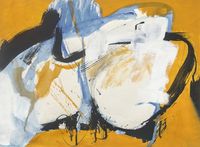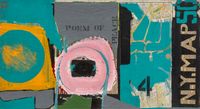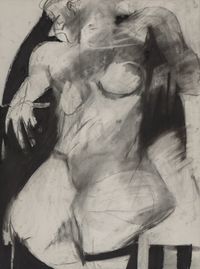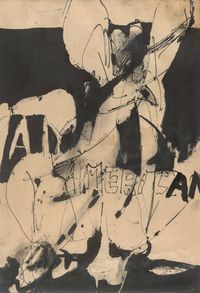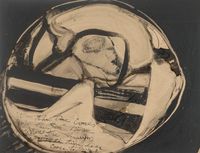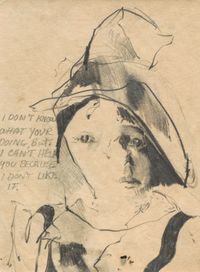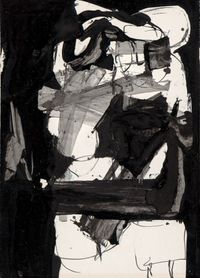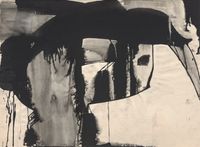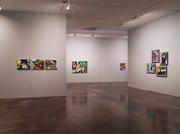Characterised by refreshing vitality, Wook-Kyung Choi's paintings, drawings, and collages reveal an artist's intellectual engagement with modes of abstraction and image-making.
Read MoreBorn and raised in Seoul, Korea, Choi moved to the United States in 1963 to study first at the Cranbrook Academy of Art, followed by the Brooklyn Museum of Art. Her paintings of the decade show the influence of American Abstract Expressionism, such as the brushwork of Willem de Kooning and Robert Motherwell. In Untitled (1968), an acrylic painting on canvas, irregular planes of orange, grey, yellow, and white are delineated by thick black lines that almost resemble claws in the centre.
In pursuit of developing her own visual language, Wook-Kyung Choi distinguished herself from American abstract expressionists in her conservation of narrative and representational elements. Another untitled painting from 1968 shows the right side of the canvas blocked in green, while the oval shape and elongated forms on the left suggest a human figure with outstretched arms.
Wook-Kyung Choi's abstract paintings also differ from the work of her Korean contemporaries associated with Dansaekhwa or the Korean monochrome painting movement, characterised by a sombre colour palette and repetitive gestures. For example, compared to Park Seo-Bo's 'Ecriture' series or Ha Chong-Hyun's 'Conjunction' series, Choi's use of bold colours and brushwork exude emotions instead of trying to subdue them.
From the mid-1970s onwards, Choi also began to employ more organic and softer pastel colours. In Unfinished Story (1977), light shades of pink, blue, green, and purple highlight curves that turn to evoke the delicate petals of flowers.
Choi's collages, which she began producing in the 1960s, suggest parallels with Pop Art in her use of everyday materials and imagery. She used newspaper clippings as a way of directly commenting on contemporary events, namely the anti-war protests and civil rights movement that were going on in the United States. Choi's approach to collage, affixing pieces of magazine and paper to the canvas, also evoke the 'combine' paintings of Robert Rauschenberg.
Choi returned to Korea in 1978, where her career was cut short by her premature death in 1985. Nevertheless, her work has been regaining attention in recent decades and in 2016, Kukje Gallery organised the retrospective exhibition Wooky-Kyung Choi: American Years 1960s-70s, which featured around 70 paintings, at their Seoul location. Further solo exhibitions include presentations at Kukje Gallery (2020) and Tina Kim Gallery, New York (2017).
Choi's works are in the collections of the Leeum Samsung Museum of Art, Seoul; National Museum of Modern and Contemporary Art, Gwacheon; and Skowhegan School of Painting and Sculpture, New York, among others.
Sherry Paik | Ocula | 2020
